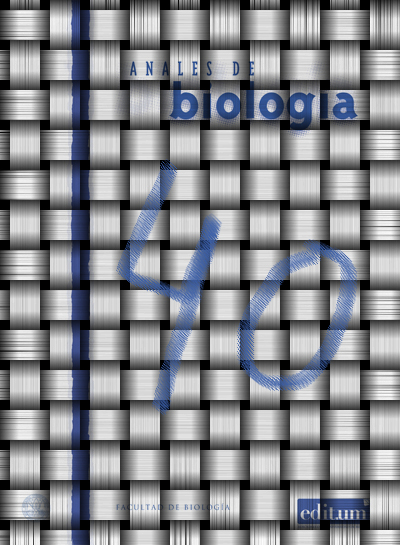Efecto in vitro sobre el crecimiento micelial y la esporulación de Ascochyta pisi Lib. de extractos crudos ocho plantas esteparias de Argelia
Resumen
Se ha estudiado el efecto de extractos crudos de ocho plantas, que crecen en la estepa argelina, contra Ascochyta pisi Lib., uno de los miembros del complejo Ascochyta que causa la antracnosis del guisante, con el objetivo de sustituirlos por fungicidas químicos con reconocida nocividad para el medio ambiente y la salud pública. Con este propósito, se realizó una prueba de control biológico in vitro del crecimiento y la esporulación de A. pisi, agregando extractos de plantas crudas o sus sub-fracciones a su medio de cultivo. Al final de este ensayo, encontramos que los extractos de Artemisia alba Turra, Lycium arabicum Schweinf. Ex Boiss. y Peganum harmala Linn. registraron las mejores tasas de inhibición del crecimiento de patógenos, mientras que Artemisia campestris L. es más efectiva contra su esporulación.
Descargas
-
Resumen178
-
PDF 72
Citas
Ahmed H, Chang KF, Hwang SF, Fu H, Zhou Q, Strelkov S, Conner R & Gossen B. 2015. Morphological characterization of fungi associated with the ascochyta blight complex and pathogenic Variability of Mycosphaerella pinodes on field pea in central Alberta. The Crop Journal 3: 10-18.
Barilli E, Cobos MJ & Rubiales D. 2016. Clarification on Host Range of Didymella pinodes the Causal Agent of Pea Ascochyta Blight. Frontiers in Plant Science 7:592 [16].
Bowen J K, Lewis BG & Matthews P. 1997. Discovery of the teleomorph of Phoma medicaginis var. pinodella in culture. Mycological Research 101(1): 80-84.
Dalili A, Bakhtiari S, Barari H & Aldaghi M. 2015. Effect of some fungicides against the growth inhibition of Sclerotinia sclerotiorum mycelial compatibility groups. Journal of Plant Protection Research 55 (4): 354-361.
Davidson JA, Hartley D, Priest M, Krysinska-Kaczmarek M, Herdina-McKay A & Scott ES. 2009. A new species of Phoma causes ascochyta blight symptoms on field peas (Pisum sativum) in South Australia. Mycologia 101: 120-128.
El Guilli M, Achbani E, Fahad K & Jijakli H. 2009. Biopesticides: Alternatives à la lutte chimique. Symposium International «Agriculture durable en région méditerranéenne», 14-16 Mai 2009, Rabat Maroc.
Fondevilla S, Cubero JL & Rubiales D. 2007. Inheritance of resistance to Mycosphaerella pinodes in two wild accessions of Pisum. European Journal of Plant Pathology 119: 53–58.
Jones WP & Kinghorn AD. 2006. Extraction of Plant Secondary Metabolites. From: Methods in Biotechnology, Natural Products Isolation. Totowa: Humana Press Inc.
Mahlo SM, McGaw LJ & Eloff JN. 2010. Antifungal activity of leaf extracts from South African trees against plant pathogens. Crop Protection 29: 1529-1533.
Ogbebor N & Adekunle AT. 2005. Inhibition of conidial germination and mycelial growth of Corynespora cassiicola (Berk & Curt) of rubber (Hevea brasiliensis muell. Arg.) using extracts of some plants. African Journal of Biotechnology 4(9): 996-1000.
Onfroy C, Baranger A & Tivoli B. 2007. Biotic factors affecting the expression of partial resistance in pea to ascochyta blight in a detached stipule assay. European Journal of Plant Pathology 119: 13-27.
Pretorius JC, Craven P & Van der Watt E. 2002. In vivo control of Mycosphaerella pinodes on pea leaves by a crude bulb extract of Eucomis autumnalis. Annals of Applied Biology 141: 125-131.
Schoeny A, Jumel S, Rouault F, Le May C & Tivoli B. 2007. Assessment of airborne primary inoculum availability and modelling of disease onset of ascochyta blight in field peas. European Journal of Plant Pathology 119: 87-97
Tadja A, Youcef Benkada M, Rickauer M, Bendahmane BS & Benkhelifa M. 2009. Characterization of Ascochyta as Pathological Species of Pea (Pisum sativum L.) at the North-West of Algeria. Journal of Agronomy 8(3): 100-106.
Tivoli B & Banniza S. 2007. Comparison of the epidemiology of ascochyta blights on grain legumes. European Journal of Plant Pathology 119: 59-76.
Tegegne G, Pretorius JC & Swart WJ. 2008. Antifungal properties of Agapanthus africanus L. extracts against plant pathogens. Crop Protection 27: 1052-1060.
Tran HS, You MP, Lanoiselet V, Khan T N & Barbetti M J. 2014. First Report of Phoma glomerata Associated with the Ascochyta Blight Complex on Field Pea (Pisum sativum) in Australia. Plant disease 98 (3): 427-427.

Esta obra está bajo una licencia internacional Creative Commons Atribución-NoComercial-SinDerivadas 4.0.
Las obras que se publican en esta revista están sujetas a los siguientes términos:
1. El Servicio de Publicaciones de la Universidad de Murcia (la editorial) conserva los derechos patrimoniales (copyright) de las obras publicadas, y favorece y permite la reutilización de las mismas bajo la licencia de uso indicada en el punto 2.
2. Las obras se publican en la edición electrónica de la revista bajo una licencia Creative Commons Reconocimiento-NoComercial-SinObraDerivada 3.0 España (texto legal). Se pueden copiar, usar, difundir, transmitir y exponer públicamente, siempre que: i) se cite la autoría y la fuente original de su publicación (revista, editorial y URL de la obra); ii) no se usen para fines comerciales; iii) se mencione la existencia y especificaciones de esta licencia de uso.
3. Condiciones de auto-archivo. Se permite y se anima a los autores a difundir electrónicamente las versiones pre-print (versión antes de ser evaluada) y/o post-print (versión evaluada y aceptada para su publicación) de sus obras antes de su publicación, ya que favorece su circulación y difusión más temprana y con ello un posible aumento en su citación y alcance entre la comunidad académica. Color RoMEO: verde.









 Biological Abstracts, BIOSIS Previews, Zoological Record
Biological Abstracts, BIOSIS Previews, Zoological Record
